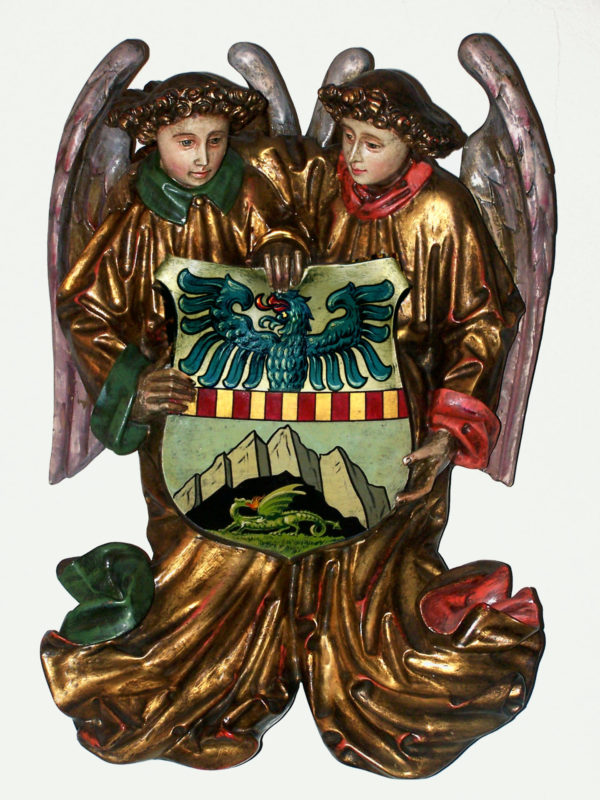
Coat of arms of the Gorup-Slavinjski family in Strmol Castle
DVORJE, CERKLJE NA GORENJSKEM, STRMOL CASTLE
Location of the coat of arms: decorative object
Strmol in Upper Carniola is one of the rare castles—or, rather, manors—in Slovenia with its interior furnishings and inventory having been preserved nearly intact to the present day. Most of its objects were collected by Rado Hribar (1901–1944), Strmol’s last prewar castellan. Apart from valuable ceramics, silverware, and glassware, many paintings, sculptures, pieces of furniture, and carpets have also been preserved. However, visitors’ attention is also drawn to an object in the first-floor hallway—a pair of angels carved in wood and gilded, holding a heraldic escutcheon. The coat of arms displayed on it belonged to Ksenija Gorup von Slavinjski (1905–1944), the wife of Rado Hribar, who was murdered with him in early January 1944 somewhere in the Cerklje forests.
The Gorup von Slavinjski family received its noble status no earlier than 1903. Its founder was Ksenija’s progressive and entrepreneurial grandfather Josip Gorup (1834–1912), a native of Slavina in Inner Carniola, who amassed enormous wealth. Josip founded his own enterprise, which primarily engaged in financial business; he invested his capital in constructing a considerable number of business, residential, and tourism facilities in Rijeka and Ljubljana, and he was also active in Austrian Carinthia and Friuli. As a patron of the arts, he donated part of his income to a multitude of cultural, humanitarian, and economic associations. Yet nothing perhaps illustrates his role in society better than the fact that, by the age of seventy, he had been named an honorary citizen or member of no fewer than seventy-five towns, market towns, villages, and associations.
For all his merits, Emperor Franz Joseph elevated Josip Gorup in 1903 to the rank of knighthood with the predicate von Slavinjski. The predicate originated from the name of Gorup’s hometown of Slavina, and his profound dedication to Slovenian culture and identity was further reflected in the newly granted noble coat of arms, with a blue eagle symbolizing Carniola. The fourteen fields in the horizontal line dividing the escutcheon probably stand for Gorup’s fourteen children, whereas the lower part of the escutcheon—depicting a cave and a dragon—was taken from the family arms of Gorup’s first wife, Ana von Perghofer. Nobility being hereditary, this coat of arms was also used by Josip’s granddaughter Ksenija (the daughter of his second-born, Milan, 1870–1914), still attesting to which is his depiction carved in wood at Strmol Castle.
Sources:
Preinfalk, Miha: Plemiški naziv in grb Josipa Gorupa. Kronika 58, 2010, no. 1 (Rodbini Kalister in Gorup), pp. 157–162.
Rugale, Mariano & Preinfalk, Miha: Blagoslovljeni in prekleti. Part 1: Plemiške rodbine 19. in 20. stoletja na Slovenskem. Ljubljana: Viharnik, 2010, pp. 70–77.
